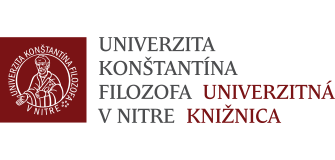HII.2015.18.introduction
INTRODUCTIONNew issue of the scientific title Music Integrations Interpretations 18 brings new themes and accents in musicological field in comparison to previous releases, dealing with Czech musical culture, relationship of philosophy and aesthetics, relationship of art, culture and education as well.
A study by Jozef Vereš Art in correlative processes (culture, education and pedagogy) deals with relation between the music (art), culture, education, pedagogy and society. Culturological nature of Vereš´s reflection is focused on education and music education, as well as recognition of new thought movement in the existing cultural and educational reality.
The American musicologist Marcus Zagorski in his study Aesthetics and Truth in Nietzsche and Adorno brings aesthetic-philosophical issues. Nietzsche´s essay Über wahrheit und Lüge im aussermoralischen Sinn and Adorno´s monography Ästhetische Theorie are being analyzed. Both texts are aesthetic-philosophical reflections aimed at the phenomenon of art, esthetics and truth. The study brings a new perspective to both philosophers in our area.
Study of Vladimir Fulka Music philosophy Th. W. Adorno is about Adorno´s musical philosophy. Elaborated study is a reflection of the 2nd Viennese School of composers such as A. Schönberg, A. Berg and A. Webern, in philosophical contexts of the Frankfurt School of Philosophy, which was initiated by Adorno as well.
Martin Flašar´s study Interpretation instead of creation: Why early music replaced the contemporary production? explores the remarkable phenomenon in the Czech musical culture " marginalizing" contemporary music by historical music. The author makes a historicizing reflection of music receptivity; accesses to the problem as a music critic and sociologist, drawing on philosophical considerations of Th. W. Adorno about current civilization and cultural trends. Current or avant-garde music is characterized pessimistically as "pro era of fear and emptiness."
The theme of Peter Macek´ s study Folkiness in Czech musical culture of postwar period focuses on Czech musical culture in the era of socialism, which was marked by the ideological aesthetic postulates of folk culture, socialist realism and the related deformation and degradation of values. Peter Macek tackles the topic of semiotic-theoretical point of view.
A study by Jan Karafiát Compositional work of Jaroslav Kvapil through Czech musicologist glance is an attempt to summarize existing opinions on Jaroslav Kvapil, including evaluations of older Czech musicology. In addition to the biography it is also Karafiát´s exploring of the composer Jaroslav Kvapil in the context of the Janáček´s stream.
Editorials
NA ÚVOD
Nové, osemnáste číslo vedeckého titulu Hudba Integrácie Interpretácie 18 prináša v porovnaní s predchádzajúcimi vydaniami nové tematické okruhy a akcenty v muzikologickej problematike, akou je česká hudobná kultúra, vzťah filozofie a estetiky, ako i vzťah umenia, kultúry a vzdelania.
Štúdia Jozefa Vereša Umenie v súvzťažných procesoch (kultúra, vzdelávanie, výchova) rieši problematiku relácii medzi hudbou (umením), kultúrou, vzdelávaním, výchovou a spoločnosťou. Kulturologický charakter Verešovej reflexie je orientovaný na oblasť školstva a hudobnej výchovy, ako i na poznávanie nových myšlienkových posunov v existujúcej kultúrnej a vzdelávacej realite.
Americký muzikológ Marcus Zagorski vo svojej štúdii Estetika a pravda u Nietzscheho a Adorna prináša esteticko-filozofickú problematiku. Analyzuje v nej Nietzscheho esej Über wahrheit und Lüge im aussermoralischen Sinn a Adornovú monografia Ästhetische Theorie. Oba texty sú esteticko-filozofickými reflexiami zameranými na fenomén umenia, estetična a pravdy. Štúdia prináša nový pohľad na oboch filozofov v našom priestore.
Aj štúdia Vladimíra Fulku Hudobná filozofia Th.W. Adorna je prácou o hudobnej filozofie Adorna. Spracovaná štúdia je reflexia 2. viedenskej školy, skladateľov A. Schönberga, A. Berga a A. Weberna, vo filozofických kontextoch frankfurtskej filozofickej školy, ktorej bol Adorno jedným z iniciátorov.
Štúdia Martina Flašara Stará místo nové. Proč interpretace nahrazuje současnou tvorbu? skúma pozoruhodný jav v českej hudobnej kultúre „marginalizovania“ súčasnej hudby historickou hudbou. Autor robí historizujúce reflexie hudobnej receptivity; pristupuje k problému ako hudobný kritik a sociológ, čerpajúc z filozofických úvah Th. W. Adorna o súčasných civilizačných a kultúrnych trendoch. Súčasnú, resp. avantgardnú hudbu charakterizuje pesimisticky ako „hudbu pro éru obav a prázdnoty.“
Témou štúdie Petra Maceka Lidovost v české hudební kultuře poválečného období je povojnová česká hudobná kultúra v ére socializmu, ktorú poznačili ideologické estetické postuláty ľudovosti, socialistického realizmu a s nimi súvisiace deformácie a degradácie hodnotových kritérií. Petr Macek rieši tému zo semioticko-teoretického hľadiska.
Štúdia Jana Karafiáta Skladatelské dílo Jaroslava Kvapila pohledem české muzikologie je pokusom o sumarizáciu doterajších pohľadov na osobnosť Jaroslava Kvapila, vrátane hodnotení staršej českej muzikológie. Okrem biografie je to aj Karafiátovo skúmanie skladateľa Jaroslava Kvapila v kontexte Janáčkovej školy.
Redakcia


